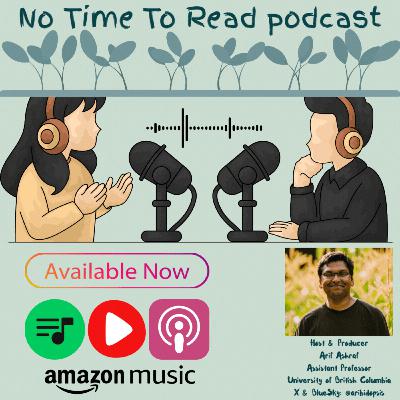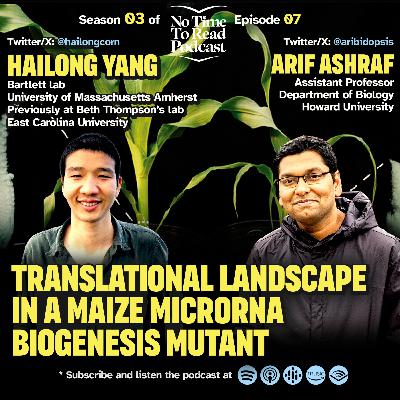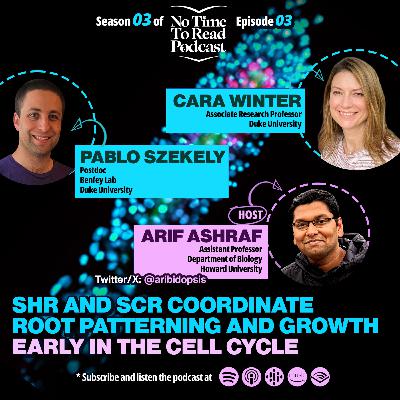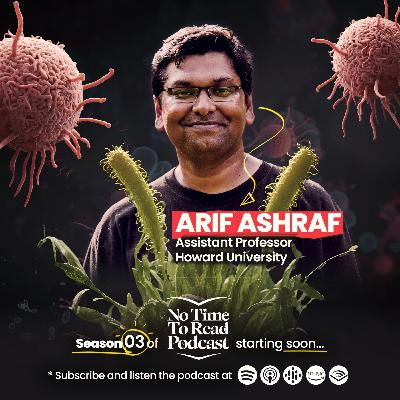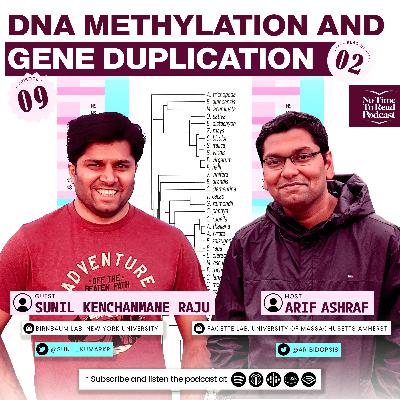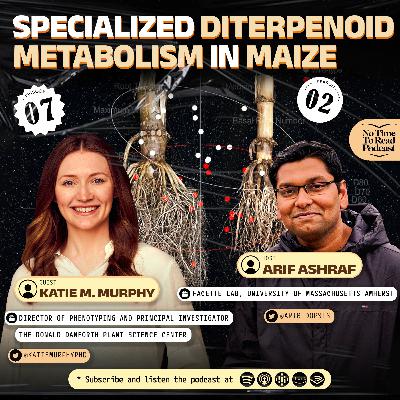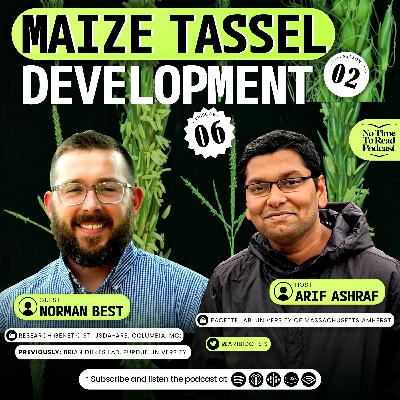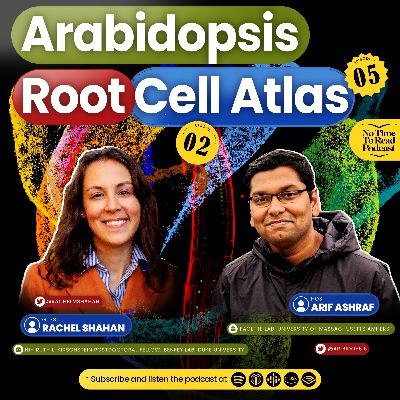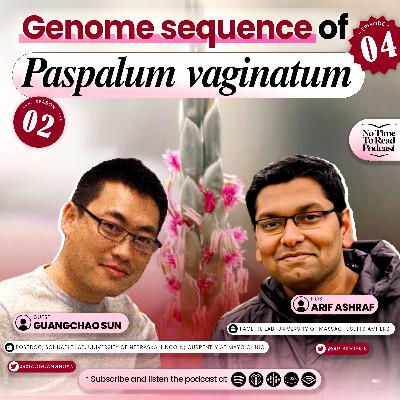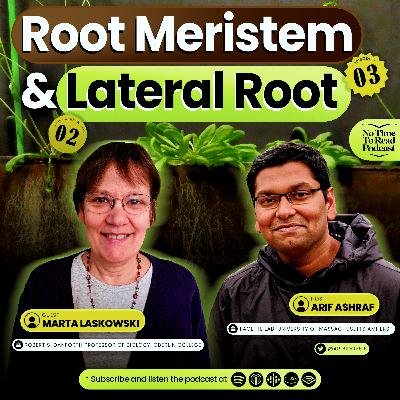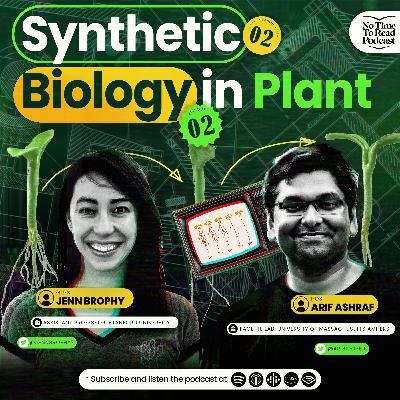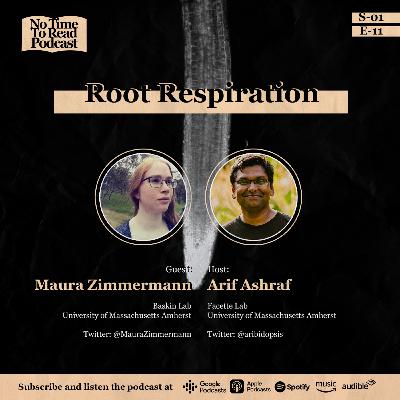Discover No Time To Read
No Time To Read

No Time To Read
Author: Arif Ashraf
Subscribed: 4Played: 36Subscribe
Share
© Arif Ashraf
Description
Arif, plant biologist and host of the podcast, will talk to lead author of a recently published plant biology paper. The guest will simply explain the story of the publication, answer questions from the host, and share personal experience and details related to the article. As an audience, you will tune in to the episode with an expectation that you will know the story of the paper without reading it. Besides, you can keep listening the podcast during your experiment, walking outside, in your car and wherever possible.
31 Episodes
Reverse
Season 4 of the No Time To Read podcast is starting soon. Thanks for your support as an audience.
No Time To Read podcast
S3E7
Translational landscape in a maize microRNA biogenesis mutant
Guest: Hailong Yang, Bartlett lab, University of Massachusetts Amherst
Previously at Beth Thompson’s lab, East Carolina University
Twitter/X: @hailongcorn
Host: Arif Ashraf, Assistant Professor, Department of Biology, Howard University
Twitter/X: @aribidopsis
No Time To Read podcast
S3E6
Cell wall integrity and endomembrane trafficking
Guest: Natalie Hoffmann, McFarlane lab, University of Toronto
Host: Arif Ashraf, Assistant Professor, Department of Biology, Howard University
Twitter/X: @aribidopsis
No Time To Read podcast
S3E5
GRASSY TILLERS1 (GT1) and SIX-ROWED SPIKE1 (VRS1) homologs share conserved roles in growth repression
Guest: Joseph Gallagher, US Department of Agriculture (USDA), Agricultural Research Service (ARS)
Twitter/X: @Joe_P_Gallagher
Host: Arif Ashraf, Assistant Professor, Department of Biology, Howard University
Twitter/X: @aribidopsis
No Time To Read podcast
S3E4
Combined plant stress database
Guest: Muthappa Senthil-Kumar, Principal Investigator, National Institute of Plant Genome Research (NIPGR), India
Twitter/X: @SCIPdatabase
Host: Arif Ashraf, Assistant Professor, Department of Biology, Howard University
Twitter/X: @aribidopsis
No Time To Read podcast
S3E3
SHR and SCR coordinate root patterning and growth early in the cell cycle
Guest:
Cara Winter, Associate Research Professor, Duke University
Pablo Szekely, Postdoc, Benfey Lab, Duke University
Host: Arif Ashraf, Assistant Professor, Department of Biology, Howard University
Twitter/X: @aribidopsis
No Time To Read podcast
S3E2
The peptide GOLVEN10 alters root development and noduletaxis in Medicago truncatula
Guest: Sonali Roy, Assistant Professor, Department of Agricultural and Environmental Sciences, Tennessee State University
Twitter/X: @SonaliRoy_
Host: Arif Ashraf, Assistant Professor, Department of Biology, Howard University
Twitter/X: @aribidopsis
No Time To Read podcast
S3E1
Plant carbonic anhydrase-like enzymes in neuroactive alkaloid biosynthesis
Guest: Ryan Nett, Assistant Professor, Department of Molecular and cellular Biology, Harvard University
Twitter/X: @rnett42
Host: Arif Ashraf, Assistant Professor, Department of Biology, Howard University
Twitter/X: @aribidopsis
Season 3 of the No Time To Read podcast is starting soon. Thanks for your support as an audience.
Article: DNA methylation signatures of duplicate gene evolution in angiosperms
Journal: Plant Physiology
Year: 2023
Guest: Sunil Kenchanmane Raju
Host: Arif Ashraf
Abstract
Gene duplication is a source of evolutionary novelty. DNA methylation may play a role in the evolution of duplicate genes (paralogs) through its association with gene expression. While this relationship has been examined to varying extents in a few individual species, the generalizability of these results at either a broad phylogenetic scale with species of differing duplication histories or across a population remains unknown. We applied a comparative epigenomic approach to 43 angiosperm species across the phylogeny and a population of 928 Arabidopsis (Arabidopsis thaliana) accessions, examining the association of DNA methylation with paralog evolution. Genic DNA methylation was differentially associated with duplication type, the age of duplication, sequence evolution, and gene expression. Whole-genome duplicates were typically enriched for CG-only gene body methylated or unmethylated genes, while single-gene duplications were typically enriched for non-CG methylated or unmethylated genes. Non-CG methylation, in particular, was a characteristic of more recent single-gene duplicates. Core angiosperm gene families were differentiated into those which preferentially retain paralogs and “duplication-resistant” families, which convergently reverted to singletons following duplication. Duplication-resistant families that still have paralogous copies were, uncharacteristically for core angiosperm genes, enriched for non-CG methylation. Non-CG methylated paralogs had higher rates of sequence evolution, higher frequency of presence–absence variation, and more limited expression. This suggests that silencing by non-CG methylation may be important to maintaining dosage following duplication and be a precursor to fractionation. Our results indicate that genic methylation marks differing evolutionary trajectories and fates between paralogous genes and have a role in maintaining dosage following duplication.
Cover art design and audio editing: Ragib Anjum
Article: Extensive embryonic patterning without cellular differentiation primes the plant epidermis for efficient post-embryonic stomatal activities
Journal: Developmental Cell
Year: 2023
Guest: Margot Smit
Host: Arif Ashraf
Abstract
Plant leaves feature epidermal stomata that are organized in stereotyped patterns. How does the pattern originate? We provide transcriptomic, imaging, and genetic evidence that Arabidopsis embryos engage known stomatal fate and patterning factors to create regularly spaced stomatal precursor cells. Analysis of embryos from 36 plant species indicates that this trait is widespread among angiosperms. Embryonic stomatal patterning in Arabidopsis is established in three stages: first, broad SPEECHLESS (SPCH) expression; second, coalescence of SPCH and its targets into discrete domains; and third, one round of asymmetric division to create stomatal precursors. Lineage progression is then halted until after germination. We show that the embryonic stomatal pattern enables fast stomatal differentiation and photosynthetic activity upon germination, but it also guides the formation of additional stomata as the leaf expands. In addition, key stomatal regulators are prevented from driving the fate transitions they can induce after germination, identifying stage-specific layers of regulation that control lineage progression during embryogenesis.
Cover art design and audio editing: Ragib Anjum
Article: A dolabralexin-deficient mutant provides insight into specialized diterpenoid metabolism in maize
Journal: Plant Physiology
Year: 2023
Guest: Katie Murphy
Host: Arif Ashraf
Abstract
Two major groups of specialized metabolites in maize (Zea mays), termed kauralexins and dolabralexins, serve as known or predicted diterpenoid defenses against pathogens, herbivores, and other environmental stressors. To consider the physiological roles of the recently discovered dolabralexin pathway, we examined dolabralexin structural diversity, tissue-specificity, and stress-elicited production in a defined biosynthetic pathway mutant. Metabolomics analyses support a larger number of dolabralexin pathway products than previously known. We identified dolabradienol as a previously undetected pathway metabolite and characterized its enzymatic production. Transcript and metabolite profiling showed that dolabralexin biosynthesis and accumulation predominantly occur in primary roots and show quantitative variation across genetically diverse inbred lines. Generation and analysis of CRISPR-Cas9-derived loss-of-function Kaurene Synthase-Like 4 (Zmksl4) mutants demonstrated dolabralexin production deficiency, thus supporting ZmKSL4 as the diterpene synthase responsible for the conversion of geranylgeranyl pyrophosphate precursors into dolabradiene and downstream pathway products. Zmksl4 mutants further display altered root-to-shoot ratios and root architecture in response to water deficit. Collectively, these results demonstrate dolabralexin biosynthesis via ZmKSL4 as a committed pathway node biochemically separating kauralexin and dolabralexin metabolism, and suggest an interactive role of maize dolabralexins in plant vigor during abiotic stress.
Cover art design and audio editing: Ragib Anjum
Article: Transcriptional responses to gibberellin in the maize tassel and control by DELLA domain proteins
Journal: The Plant Journal
Year: 2022
Guest: Norman Best
Host: Arif Ashraf
Abstract
The plant hormone gibberellin (GA) impacts plant growth and development differently depending on the developmental context. In the maize (Zea mays) tassel, application of GA alters floral development, resulting in the persistence of pistils. GA signaling is achieved by the GA-dependent turnover of DELLA domain transcription factors, encoded by dwarf8 (d8) and dwarf9 (d9) in maize. The D8-Mpl and D9-1 alleles disrupt GA signaling, resulting in short plants and normal tassel floret development in the presence of excess GA. However, D9-1 mutants are unable to block GA-induced pistil development. Gene expression in developing tassels of D8-Mpl and D9-1 mutants and their wild-type siblings was determined upon excess GA3 and mock treatments. Using GA-sensitive transcripts as reporters of GA signaling, we identified a weak loss of repression under mock conditions in both mutants, with the effect in D9-1 being greater. D9-1 was also less able to repress GA signaling in the presence of excess GA3. We treated a diverse set of maize inbred lines with excess GA3 and measured the phenotypic consequences on multiple aspects of development (e.g., height and pistil persistence in tassel florets). Genotype affected all GA-regulated phenotypes but there was no correlation between any of the GA-affected phenotypes, indicating that the complexity of the relationship between GA and development extends beyond the two-gene epistasis previously demonstrated for GA and brassinosteroid biosynthetic mutants.
Cover art design and audio editing: Ragib Anjum
Article: A single-cell Arabidopsis root atlas reveals developmental trajectories in wild-type and cell identity mutants
Journal: Developmental Cell
Year: 2022
Guest: Rachel Shahan
Host: Arif Ashraf
Abstract
In all multicellular organisms, transcriptional networks orchestrate organ development. The Arabidopsis root, with its simple structure and indeterminate growth, is an ideal model for investigating the spatiotemporal transcriptional signatures underlying developmental trajectories. To map gene expression dynamics across root cell types and developmental time, we built a comprehensive, organ-scale atlas at single-cell resolution. In addition to estimating developmental progressions in pseudotime, we employed the mathematical concept of optimal transport to infer developmental trajectories and identify their underlying regulators. To demonstrate the utility of the atlas to interpret new datasets, we profiled mutants for two key transcriptional regulators at single-cell resolution, shortroot and scarecrow. We report transcriptomic and in vivo evidence for tissue trans-differentiation underlying a mixed cell identity phenotype in scarecrow. Our results support the atlas as a rich community resource for unraveling the transcriptional programs that specify and maintain cell identity to regulate spatiotemporal organ development.
Cover art design and audio editing: Ragib Anjum
Article: Genome of Paspalum vaginatum and the role of trehalose mediated autophagy in increasing maize biomass
Journal: Nature Communications
Year: 2022
Guest: Guangchao Sun
Host: Arif Ashraf
Abstract
A number of crop wild relatives can tolerate extreme stress to a degree outside the range observed in their domesticated relatives. However, it is unclear whether or how the molecular mechanisms employed by these species can be translated to domesticated crops. Paspalum (Paspalum vaginatum) is a self-incompatible and multiply stress-tolerant wild relative of maize and sorghum. Here, we describe the sequencing and pseudomolecule level assembly of a vegetatively propagated accession of P. vaginatum. Phylogenetic analysis based on 6,151 single-copy syntenic orthologues conserved in 6 related grass species places paspalum as an outgroup of the maize-sorghum clade. In parallel metabolic experiments, paspalum, but neither maize nor sorghum, exhibits a significant increase in trehalose when grown under nutrient-deficit conditions. Inducing trehalose accumulation in maize, imitating the metabolic phenotype of paspalum, results in autophagy dependent increases in biomass accumulation.
Cover art design and audio editing: Ragib Anjum
Article: The miR156 juvenility factor and PLETHORA 2 form a regulatory network and influence timing of meristem growth and lateral root emergence
Journal: Development
Year: 2022
Guest: Marta Laskowski
Host: Arif Ashraf
Abstract
Plants develop throughout their lives: seeds become seedlings that mature and form fruits and seeds. Although the underlying mechanisms that drive these developmental phase transitions have been well elucidated for shoots, the extent to which they affect the root is less clear. However, root anatomy does change as some plants mature; meristems enlarge and radial thickening occurs. Here, in Arabidopsis thaliana, we show that overexpressing miR156A, a gene that promotes the juvenile phase, increased the density of the root system, even in grafted plants in which only the rootstock had the overexpression genotype. In the root, overexpression of miR156A resulted in lower levels of PLETHORA 2, a protein that affects formation of the meristem and elongation zone. Crossing in an extra copy of PLETHORA 2 partially rescued the effects of miR156A overexpression on traits affecting root architecture, including meristem length and the rate of lateral root emergence. Consistent with this, PLETHORA 2 also inhibited the root-tip expression of another miR156 gene, miR156C. We conclude that the system driving phase change in the shoot affects developmental progression in the root, and that PLETHORA 2 participates in this network.
Cover art design and audio editing: Ragib Anjum
Article: Synthetic genetic circuits as a means of reprogramming plant roots
Journal: Science
Year: 2022
Guest: Jenn Brophy
Host: Arif Ashraf
Abstract
The shape of a plant’s root system influences its ability to reach essential nutrients in the soil and to acquire water during drought. Progress in engineering plant roots to optimize water and nutrient acquisition has been limited by our capacity to design and build genetic programs that alter root growth in a predictable manner. We developed a collection of synthetic transcriptional regulators for plants that can be compiled to create genetic circuits. These circuits control gene expression by performing Boolean logic operations and can be used to predictably alter root structure. This work demonstrates the potential of synthetic genetic circuits to control gene expression across tissues and reprogram plant growth.
Cover art design and audio editing: Ragib Anjum
Article: CAN OF SPINACH, a novel long non-coding RNA, affects iron deficiency responses in Arabidopsis thaliana
Journal: Frontiers in Plant Science
Year: 2022
Guest: Ahmet Bakirbas
Host: Arif Ashraf
Abstract
Long non-coding RNAs (lncRNAs) are RNA molecules with functions independent of any protein-coding potential. A whole transcriptome (RNA-seq) study of Arabidopsis shoots under iron sufficient and deficient conditions was carried out to determine the genes that are iron-regulated in the shoots. We identified two previously unannotated transcripts on chromosome 1 that are significantly iron-regulated. We have called this iron-regulated lncRNA, CAN OF SPINACH (COS). cos mutants have altered iron levels in leaves and seeds. Despite the low iron levels in the leaves, cos mutants have higher chlorophyll levels than WT plants. Moreover, cos mutants have abnormal development during iron deficiency. Roots of cos mutants are longer than those of WT plants, when grown on iron deficient medium. In addition, cos mutant plants accumulate singlet oxygen during iron deficiency. The mechanism through which COS affects iron deficiency responses is unclear, but small regions of sequence similarity to several genes involved in iron deficiency responses occur in COS, and small RNAs from these regions have been detected. We hypothesize that COS is required for normal adaptation to iron deficiency conditions.
Cover art design and audio editing: Ragib Anjum
Article: Alternative photosynthesis pathways drive the algal CO2-concentrating mechanism
Journal: Nature
Year: 2022
Guest: Adrien Burlacot
Host: Arif Ashraf
Abstract
Global photosynthesis consumes ten times more CO2 than net anthropogenic emissions, and microalgae account for nearly half of this consumption. The high efficiency of algal photosynthesis relies on a mechanism concentrating CO2 (CCM) at the catalytic site of the carboxylating enzyme RuBisCO, which enhances CO2 fixation. Although many cellular components involved in the transport and sequestration of inorganic carbon have been identified how microalgae supply energy to concentrate CO2 against a thermodynamic gradient remains unknown. Here we show that in the green alga Chlamydomonas reinhardtii, the combined action of cyclic electron flow and O2 photoreduction—which depend on PGRL1 and flavodiiron proteins, respectively—generate a low luminal pH that is essential for CCM function. We suggest that luminal protons are used downstream of thylakoid bestrophin-like transporters, probably for the conversion of bicarbonate to CO2. We further establish that an electron flow from chloroplast to mitochondria contributes to energizing non-thylakoid inorganic carbon transporters, probably by supplying ATP. We propose an integrated view of the network supplying energy to the CCM, and describe how algal cells distribute energy from photosynthesis to power different CCM processes. These results suggest a route for the transfer of a functional algal CCM to plants to improve crop productivity.
Art credit: Solène Moulin
Cover art design and audio editing: Ragib Anjum
Article: Oxygen uptake rates have contrasting responses to temperature in the root meristem and elongation zone
Journal: Physiologia Plantarum
Year: 2022
Guest: Maura Zimmermann
Host: Arif Ashraf
Abstract
Growing at either 15 or 25°C, roots of Arabidopsis thaliana, Columbia accession, produce cells at the same rate and have growth zones of the same length. To determine whether this constancy is related to energetics, we measured oxygen uptake by means of a vibrating oxygen-selective electrode. Concomitantly, the spatial distribution of elongation was measured kinematically, delineating meristem and elongation zone. All seedlings were germinated, grown, and measured at a given temperature (15 or 25°C). Columbia was compared to lines where cell production rate roughly doubles between 15 and 25°C: Landsberg and two Columbia mutants, er-105 and ahk3-3. For all genotypes and temperatures, oxygen uptake rate at any position was highest at the root cap, where mitochondrial density was maximal, based on the fluorescence of a reporter. Uptake rate declined through the meristem to plateau within the elongation zone. For oxygen uptake rate integrated over a zone, the meristem had steady-state Q10 values ranging from 0.7 to 2.1; by contrast, the elongation zone had values ranging from 2.6 to 3.3, implying that this zone exerts a greater respiratory demand. These results highlight a substantial energy consumption by the root cap, perhaps helpful for maintaining hypoxia in stem cells, and suggest that rapid elongation is metabolically more costly than is cell division.
Cover art design and audio editing: Ragib Anjum


